4.1 为什么收集Nginx日志
我们需要获取用户的信息,比如:来源的IP是哪个地域,网站的PV、UV、状态码、访问时间等等;所以需要收集 Nginx 日志;
4.2 Nginx日志收集架构图
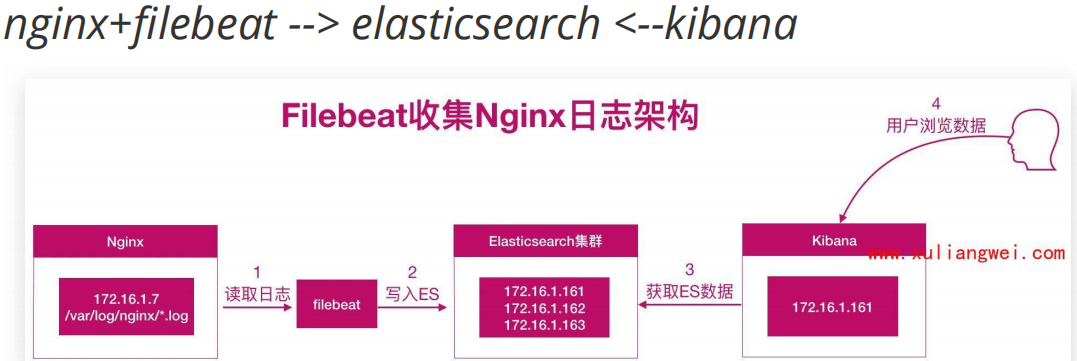
4.3 Nginx日志收集实践
4.3.1 安装Nginx
yum install nginx -y
cat /etc/nginx/conf.d/elk.conf
server {
listen 5555;
server_name elk.bertwu.net;
location / {
root /code;
index index.html;
}
}
systemctl start nginx
4.3.2 配置filebeat
配置Filebeat,收集本机Nginx日志
cat filebeat.yml
filebeat.inputs:
- type: log
enabled: true
paths: /var/log/nginx/access.log
output.elasticsearch:
hosts: ["172.16.1.161:9200","172.16.1.162:9200","172.16.1.163:9200"]
index: "nginx-access-%{[agent.version]}-%{+yyyy.MM.dd}" #自定义索引名称
setup.ilm.enabled: false
setup.template.name: "nginx" #定义模板名称
setup.template.pattern: "nginx-*" #定义模板的匹配索引名称
systemctl restart filebeat
4.3.3 kibana展示
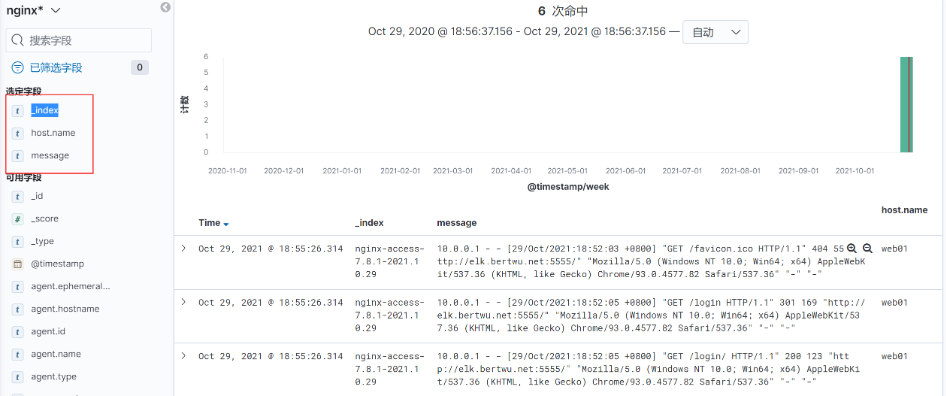
4.4 Nginx Json日志收集实践
4.4.1 收集问题
我们实现了 Nginx 日志的收集,但是所有的数据都在 message 字段中,无法满足分析的需求,比如:
需要统计状态码的情况;
统计所有请求总产生的流量大小;
统计来源使用的客户端;等等
这些是没有办法实现的
4.4.2 解决方案
需要将日志中的每一个选项都拆分出来,拆分成 key-value 的形式,那么就需要借助 json 的格式。
4.4.3 配置Json
1.重置nginx日主格式为json格式
log_format json '{ "time_local": "$time_local",'
'"remote_addr": "$remote_addr",'
'"referer": "$http_referer",'
'"request": "$request",'
'"status": $status,'
'"bytes": $body_bytes_sent,'
'"test_agent": "$http_user_agent",'
'"x_forwarded": "$http_x_forwarded_for",'
'"up_addr": "$upstream_addr",'
'"up_host": "$upstream_http_host",'
'"upstream_time": "$upstream_response_time",'
'"request_time": "$request_time"'
'}';
2.重新配置nginx.conf
cat /etc/nginx/conf.d/elk.conf
server {
listen 5555;
server_name elk.bertwu.net;
access_log /var/log/nginx/access.log json; # 定义日志格式为json
location / {
root /code;
index index.html;
}
}
3.重新配置filebeat文件
[root@web01 filebeat]# cat filebeat.yml
filebeat.inputs:
- type: log
enabled: true
paths: /var/log/nginx/access.log
json.keys_under_root: true # Flase会将json解析的格式存储至messages,改为true则不存储至
json.overwrite_keys: true #覆盖默认message字段,使用自定义json格式的key
output.elasticsearch:
hosts: ["172.16.1.161:9200","172.16.1.162:9200","172.16.1.163:9200"]
index: "nginx-access-%{[agent.version]}-%{+yyyy.MM.dd}" #自定义索引名称
setup.ilm.enabled: false
setup.template.name: "nginx" #定义模板名称
setup.template.pattern: "nginx-*" #定义模板的匹配索引名称
4.重启filebeat、Nginx,然后清空日志,在重新产生json格式的日志
systemctl restart nginx
systemctl restart filebeat
> /var/log/nginx/access.log
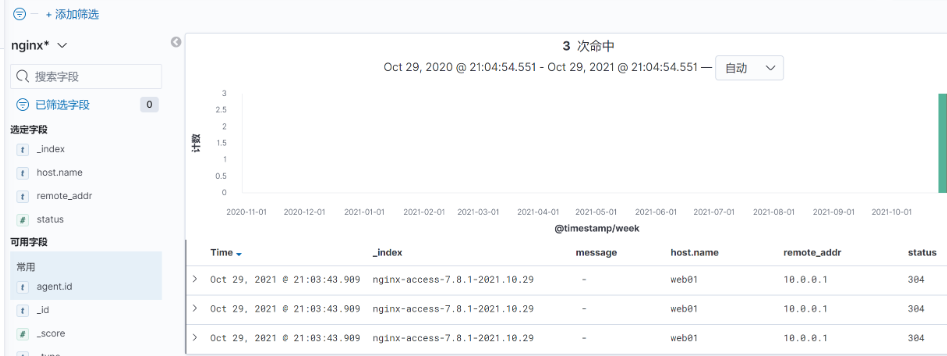
4.5 Nginx多个日志收集实践
nginx 存在访问日志和错误日志,那么如何使用filebeat 同时收集 nginx 的访问日志、错误日志;
我们希望的状态如下:
nginx访问日志 --存储–> nginx-access-xxx 索引
nginx错误日志 --存储–> nginx-error-xxx 索引
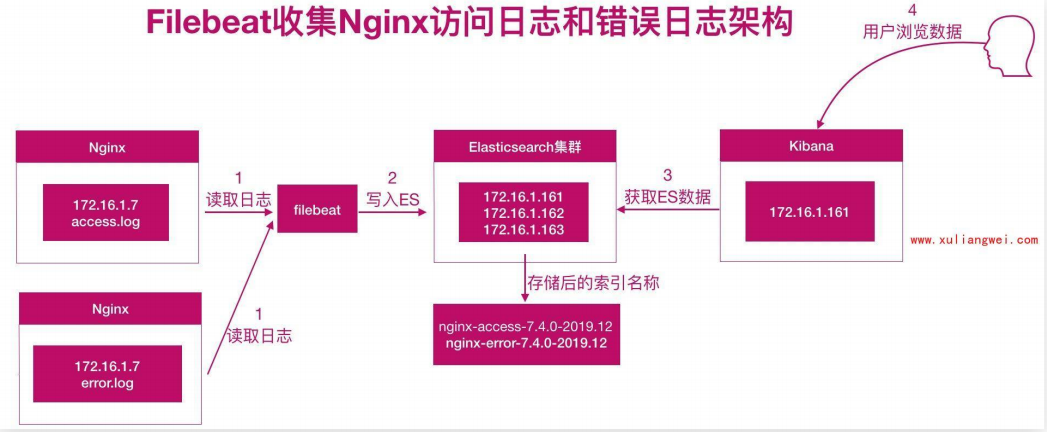
1.配置 filebeat 收集多个日志,需要通过 tags 标签进行区分;
cat filebeat.yml
filebeat.inputs:
- type: log
enabled: true
paths: /var/log/nginx/access.log
json.keys_under_root: true
json.overwrite_keys: true
tags: ["access"]
- type: log
enabled: true
paths: /var/log/nginx/error.log
tags: ["error"]
output.elasticsearch:
hosts: ["172.16.1.161:9200","172.16.1.162:9200","172.16.1.163:9200"]
indices:
- index: "nginx-access-%{[agent.version]}-%{+yyyy.MM.dd}" #自定义索引名称
when.contains:
tags: "access"
- index: "nginx-error-%{[agent.version]}-%{+yyyy.MM.dd}"
when.contains:
tags: "error"
setup.ilm.enabled: false #索引生命周期ilm功能默认开启,开启情况下索引名称只能为filebeat-*
setup.template.name: "nginx" #定义模板名称
setup.template.pattern: "nginx-*" #定义模板的匹配索引名称
2.重启filebeat
systemctl restart filebeat
3.使用kibana添加nginx错误日志索引,然后展示数据
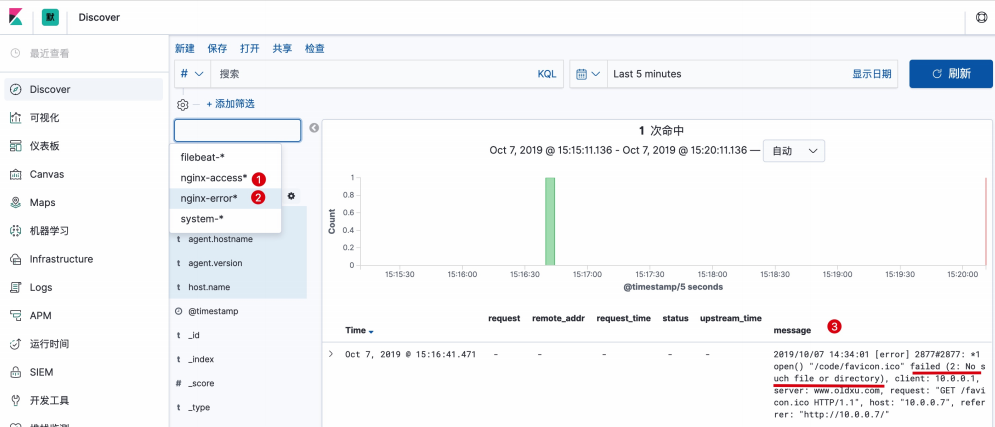
4.6 Nginx多虚拟主机收集实践
Nginx 如果有多个站点;filebeat 该如何收集多个域名的访问日志
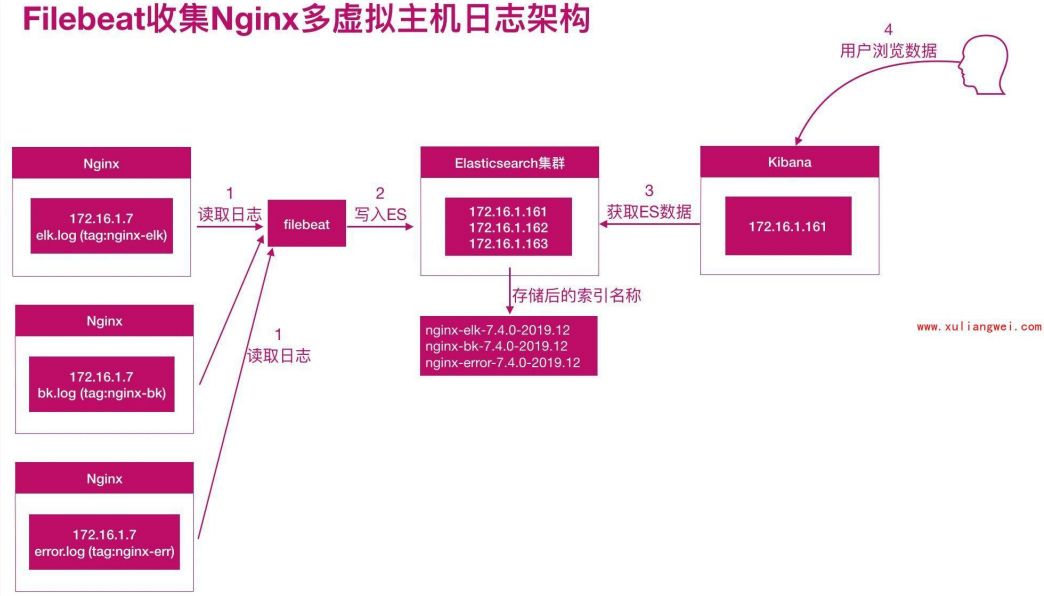
1.配置nginx多站点
[root@web01 ~]# cat /etc/nginx/conf.d/elk.conf
server {
listen 5555;
server_name elk.qingchen.net;
access_log /var/log/nginx/access.log json;
location / {
root /code;
index index.html;
}
}
server {
listen 5555;
server_name blog.qingchen.net;
access_log /var/log/nginx/blog.log json;
location / {
root /code;
index index.html;
}
}
server {
listen 5555;
server_name www.qingchen.net;
access_log /var/log/nginx/www.log json;
location / {
root /code;
index index.html;
}
}
2.配置filebeat
cat filebeat.yml
filebeat.inputs:
- type: log
enabled: true
paths: /var/log/nginx/access.log
json.keys_under_root: true
json.overwrite_keys: true
tags: ["access"]
- type: log
enabled: true
paths: /var/log/nginx/error.log
tags: ["error"]
- type: log
enabled: true
paths: /var/log/nginx/www.log
json.keys_under_root: true
json.overwrite_keys: true
tags: ["nginx-www"]
- type: log
enabled: true
paths: /var/log/nginx/blog.log
json.keys_under_root: true
json.overwrite_keys: true
tags: ["nginx-blog"]
output.elasticsearch:
hosts: ["172.16.1.161:9200","172.16.1.162:9200","172.16.1.163:9200"]
indices:
- index: "nginx-access-%{[agent.version]}-%{+yyyy.MM.dd}" #自定义索引名称
when.contains:
tags: "access"
- index: "nginx-error-%{[agent.version]}-%{+yyyy.MM.dd}"
when.contains:
tags: "error"
- index: "nginx-www-%{[agent.version]}-%{+yyyy.MM.dd}"
when.contains:
tags: "nginx-www"
- index: "nginx-blog-%{[agent.version]}-%{+yyyy.MM.dd}"
when.contains:
tags: "nginx-blog"
setup.ilm.enabled: false
setup.template.name: "nginx" #定义模板名称
setup.template.pattern: "nginx-*" #定义模板的匹配索引名称
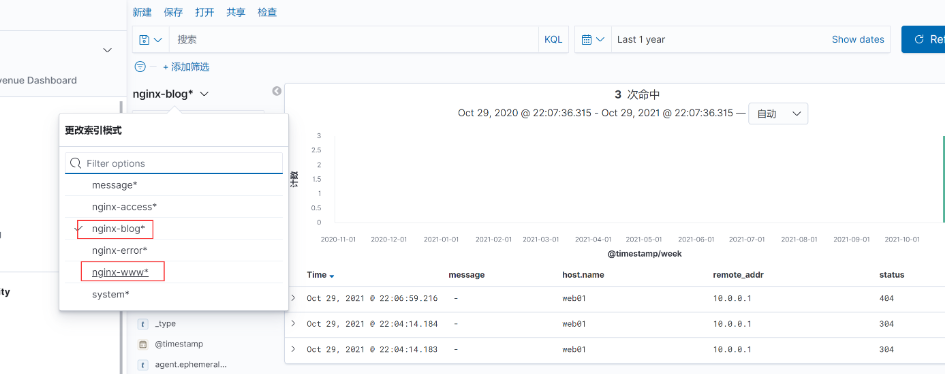
| 阿里云国内75折 回扣 微信号:monov8 |
| 阿里云国际,腾讯云国际,低至75折。AWS 93折 免费开户实名账号 代冲值 优惠多多 微信号:monov8 飞机:@monov6 |








